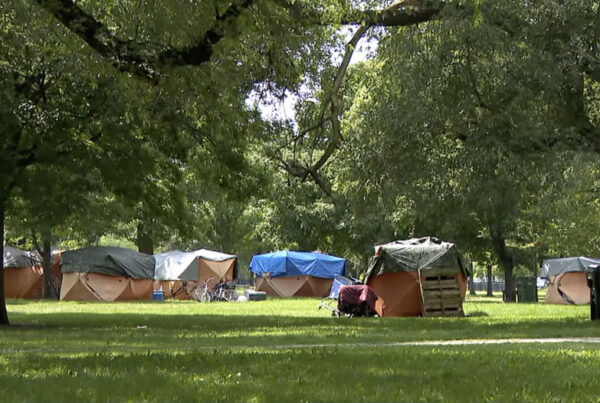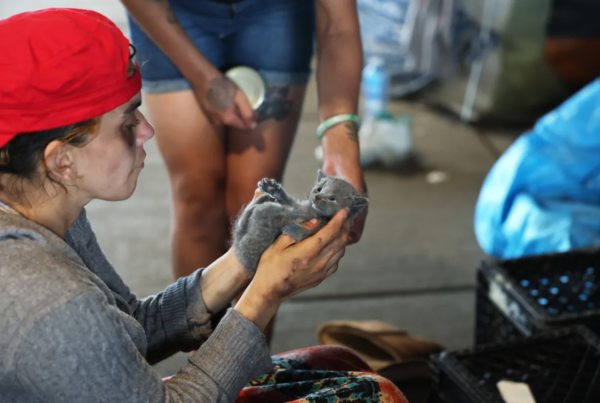By Mary Wisniewski
The more than three dozen people who live in tents under the Lake Shore Drive bridges at Wilson and Lawrence avenues know better than anyone that the structures need repair.
Concrete from the Depression-era bridges is crumbling onto the sidewalks and streets below, posing a deadly hazard to tent-dwellers, as well as motorists, bicyclists and pedestrians.
So it may seem strange that a homeless advocacy group might sue the city to stop bridge repairs before they start in mid-September. But attorneys for the Chicago Coalition for the Homeless want to stop the city’s plans to put bike paths on the wide sidewalks under the bridges, which the coalition said would permanently drive the homeless out.
“If they put the bike paths in, we ain’t going to have room for our tents,” said Thomas Gordon, 58, who lives under the Lawrence bridge. The sidewalks can currently accommodate both tents and pedestrians — bike paths would cut the space.
The dilemma highlights two local trends — the decrease in affordable housing on the city’s North Side, as single-resident occupancy hotels are converted into apartments, and the popularity of biking. Chicago has worked for years to become more bike friendly, but homeless advocates say it is not necessary to permanently displace the tent cities at Wilson and Lawrence avenues to accommodate cyclists.
“A redesign that places a bike lane in the street would be safer for pedestrians, bikers and cars alike,” said Diane O’Connell, staff attorney for the coalition. The coalition sent a letter to the city threatening a lawsuit. The advocacy group wants to stop construction unless the city agrees to provide permanent housing for those displaced and agrees to a design that does not prevent the homeless from returning.
The coalition claimed in its Aug. 9 letter that the current design “appears to be intentionally discriminatory, in violation of state law, in that the plans are motivated by no other purpose than to keep homeless people out of areas where they have long lived, some for years.”
In its response last Friday, the city said that officials had been prepared to meet with the coalition and viaduct residents in May to discuss concerns about the project, but the coalition canceled the meeting. The city also argued that it has been helping residents find alternative permanent housing.
“The city has not acted in a discriminatory fashion at any point during this process; indeed, it has been acutely sensitive to the needs and wishes of the [coalition] and the Viaduct residents,” wrote Andrew Worseck, chief assistant corporation counsel.
The homeless coalition says that Wilson, which sees 8,700 cars daily, and Lawrence, which sees 15,500 cars, are good candidates for a “road diet” — a plan that shrinks car space to make room for cyclists and pedestrians. For roads with less than 19,000 cars a day, one lane in each direction is sufficient, according to transportation experts cited by the coalition. Wilson and Lawrence each have two lanes in each direction.
The Active Transportation Alliance, which advocates for bicyclists and pedestrians, is waiting for more information and has not yet taken a position, said Kyle Whitehead, government relations director.
Valarie Attah, an Uptown resident, thinks putting bike lanes on the sidewalks separate from vehicle traffic makes sense, considering how busy Wilson and Lawrence get on weekends, and that there is a world-class bike trail just feet from the viaducts.
“I think dividing the wide sidewalks to get more Chicagoans safely between the city and the park is keeping with the spirit of the creation of the viaducts back in 1933,” Attah said.
This would not be the first time a city project pushed out a homeless camp. In 2014, concrete barriers were erected under the Kennedy Expressway at Belmont Avenue. In that case, local officials said that the barriers were erected with the intent of dislodging a decade-old settlement. Construction was halted after police complained the barriers blocked their view of the sidewalk.
Bans and barriers that prevent homeless camps are a national trend, said Tristia Bauman, senior attorney at the National Law Center on Homelessness and Poverty in Washington, D.C. The center has seen other examples of cities clearing out homeless camps to make repairs on structures, which is understandable, but then putting in fences or “no trespassing” signs to keep the homeless from returning. Bike lanes on sidewalks are something new, Bauman said.
“Visible poverty is hard to see — it makes people uncomfortable,” Bauman said. “Cities realize that shoppers, potential real estate owners and businesses don’t want to be confronted with visible poverty.”
Repairs to the bridges at Wilson and Lawrence avenues are expected to take about eight months and will require the tent-dwellers to find another place to stay, even if there were no bike paths.
Joel Mitchell, deputy commissioner of Family and Support Services, said the city has worked with homeless people under the viaduct for more than a year to inform them of available resources, and placed 50 people in permanent supportive housing. He said the city currently has 19 housing units available for the most vulnerable people and is advising others on going to shelters.
“Most vulnerable” means those with physical and/or mental impairment who may need hospitalization. The city is assessing who fits into that category. “It’s our goal to get people placed as fast as we can,” Mitchell said. He does not know when they would be placed.
Meanwhile, the affordable housing situation in Uptown is expected to get worse. Last month, the Wilson Men’s Hotel was sold, and the new owner plans to reduce the number of units from about 250 to about 75, with higher rents, according to ONE Northside, a community organization.
Gordon, who gets disability payments due to herniated discs and chronic arthritis, used to live in the Lawrence House SRO before it closed. He then stayed with a friend until the friend died, and then Gordon moved onto the Lawrence viaduct.
Gordon said he hopes the city will help him and others from the camps find homes. “I would rather not live under a bridge,” Gordon said.
Work on the bridge will start in 2019 and take about a year, said Transportation Department spokesman Claffey. It will serve pedestrians and bikes.








